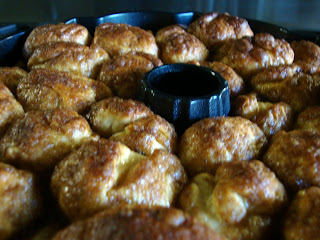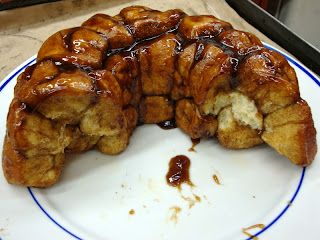
Monkey Bubble Bread
Whenever I would come across a recipe for Monkey Bread, something about the name would make me smile. And each time I thought I'm going to make this. Then the book is put down and the recipe forgotten; until now. After seeing a similar recipe on-line off I went to retrieve the book; on to the bookstand it went, opened to the appropriate page, waiting patiently for me to begin.
I really should not cook and blog on two recipes at the same time for mistakes are bound to happen; such as putting in only three tablespoons of butter instead of the five tablespoons the recipe called for. You can say this is a lower-fat version! It was still very good and the guys at the shop polished it off with no complaints. The plate came home empty.
Success meter (1-3): 3

amazon.com

Monkey Bubble Bread
Yield: One 10-inch Bundt
1 ¼ cups whole milk
2 tsp instant yeast
4 cups all-purpose flour
5 Tbl sugar
1 tsp salt
1 egg
5 Tbl unsalted butter, melted
1 ¼ cups firmly packed dark brown sugar
2 tsp cinnamon
¼ cup (1 stick) unsalted butter, melted and cooled
Make the Monkey Bubble Bread
Generously spray the inside of a 10-inch Bundt pan with nonstick cooking spray.
In a small saucepan, warm your milk to slightly above room temperature, then remove it from the heat, add the yeast, and whisk to dissolve. (Do not warm it beyond 110 degrees F or you will kill the yeast.)
In the bowl of a standing mixer fitted with the paddle attachment, beat the flour, sugar, and salt until combined.
In a small bowl, beat the egg with a fork and add it to the dry ingredients. Mix on low speed until combined.
Keeping the mixer on low, slowly stream in the milk until combined. Add the melted butter and mix until the dough comes together. Replace the paddle attachment with the dough hook attachment. Continue to mix on medium speed until the dough becomes silky and tacky, but not sticky, 8 to 10 minutes. The dough should mound together and easily come off the bottom of the mixing bowl. (If the dough is too wet, add some flour. If it is too dry, add a tiny bit of water.)
Spray the bottom and sides of a large bowl with cooking spray. Place the dough in the bowl and roll it around to make sure it is completely covered in oil. Cover the bowl with plastic wrap or a dish towel and let it rest in a warm area until the dough has doubled in size, approximately 1 hour.
Line a sheet pan with parchment paper.
Use your clean hands to push down and deflate the dough. Remove it from the bowl and pat it into a rough circle approximately 8 inches in diameter. Use a bench knife or serrated knife to cut dough into 1 to 1 ½-inch pieces (about ½ ounce each) – alternatively, use your hands to pinch apart the dough. Roll the pieces into balls (they don’t have to be perfectly round). Place the balls on the sheet pan (you will get about 60 pieces in all). Cover the balls lightly with plastic wrap.
Make the Cinnamon Sugar Coating
In a small bowl, stir together the sugar and cinnamon. Place the melted butter in a separate bowl.
Assemble the Bread
Remove the plastic wrap from the dough balls and dip one ball in the melted butter. Let the excess butter drip back into the bowl, roll the ball in the brown sugar mixture, and place it in the Bundt pan. Continue this process with each ball, until you have several layers, arranging them as if you are building a brick wall.
Wrap the Bundt pan tightly in plastic wrap. Set it in a warm area of the house for about 1 hour, or until the dough balls have doubled in size and appear puffy.
Preheat the oven to 350 degrees F. remove the plastic and bake the Bundt until the top layer is deep brown and the caramel coating begins to bubble around the edges, about 30 minutes.
Cool the bread for 5 minutes, then turn it out directly onto a platter and serve warm. Should you have any leftovers (this is rare, I promise you), simply re-heat them in a 300-degree oven until warm to the touch.
Note: You can make the dough ahead of time. Once the dipped dough has been placed in the pan, wrap it tightly, refrigerate it, and bring it back to room temperature to “proof” the dough before baking. This is one of those breads that exists to be eaten warm, straight from the oven.




















No comments:
Post a Comment
Thanks for visiting! Would love to hear from you - feel free to comment.